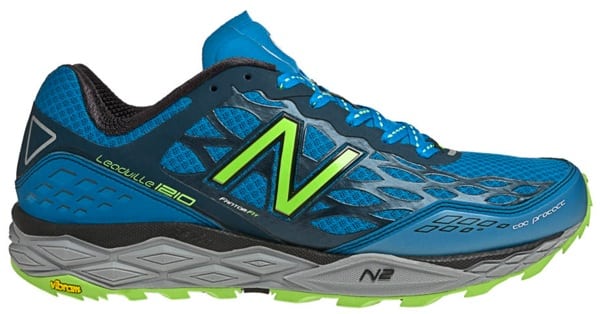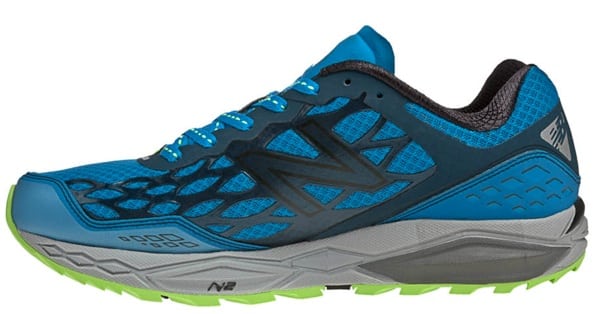Our Favorite Trail Running Shoes
Check out our Best Trail Running Shoes article to learn about our current favorite trail running shoes!
New Balance Leadville 1210 Review
When we look back at the minimalist trend that has been on the forefront of the running shoe industry for the last several years we will most certainly point to New Balance as being a driving force in that movement. Great, what does that have to do with a “normal” trail shoe? Thankfully, a lot. The trend to lower and lighter has forced many a designer to stop and rethink the tooling of traditional trail shoes. The New Balance Leadville 1210 ($125) is an example of applying the knowledge and material used in minimal shoes and pushing them toward a shoe that is focused on the masses and built specifically ultrarunning.
The Leadville 1210 is neither a lightweight nor a heavyweight at 10.3 ounces in a men’s size 9, though it fits a 1/2 size large, so it really is a smidge lighter. It features a 8mm drop, which seems to be a happy medium for getting lower to the ground without overworking those Achilles. You can see some common styles with the Minimus line with the waffle mesh along with laminated overlays to add structured support to the upper and outsole is provided by Vibram. The shoe has all the features you have come to expect from a standard trail runner: low-profile lugs, toe bumper, rock plate, along with a small fatigue post to help in those later miles when form falls apart.
Below we cover off on New Balance’s first targeted ultrarunning shoe. Give it a look and tell us what you think.
[Editor’s Notes:
- While we were unable to update our video review, we’ve updated the transcript below to clarify a mixup regarding the use of N2 and REVlite in the shoe.
- During last year’s Leadville 100, we interviewed Bryan Gothie, Senior Product Manager at New Balance, about the New Balance Leadville 1210’s features.]
[Click here if you can’t see the video above.]
New Balance Leadville 1210 Review Transcript
Hey and welcome to Trail Trials, the video review section of iRunFar.com. My name is Travis Liles, and in this video we’re going to take a look at the New Balance MT 1210 Leadville.
The New Balance MT 1210, the “Leadville,” is New Balance’s first shoe that they’ve really positioned as an ultrarunning shoe. You see it in their marketing and online. You also see it just in the name of the shoe—the Leadville. This is really positioned to be an ultrarunning shoe. How this differs from what New Balance has done over the last several years is that this is not a minimal shoe. This is a shoe for the masses.

The New Balance Leadville 1210
What we see are a lot of great features that have been taken from that minimal line, so it’s not just a road shoe with some beefed up tread. It really is a shoe that they’ve taken some time and some effort to build a shoe that is trail running specific while taking some of the heritage of that minimal line and applying it to a shoe that is definitely in the middle of the road in terms of cushioning and support and those sorts of things. To give you some quick specs, the Leadville is a 10.3oz shoe with an 8mm drop and a slight bit of pronation control. With that said, let’s get up close and personal and see what we think about the MT 1210 Leadville from New Balance.
Outsole
Let’s start off by looking at the outsole of the Leadville. We can see from the branding on the side of the shoe as well as the bottom that this is a Vibram outsole. That means we’ve got some durable rubber that is going to hang around for awhile, which is the reputation of Vibram. These shoes have forward-facing and reverse-facing lugs. We can see the forward-facing lugs being on the front so that going uphill they give us traction. Then as we transition from the midfoot and back to the heel we move to a rear-facing lug so we can break going downhill and have traction. Then there is a full-on heel break as we go all the way to the outer back part of the heel where generally we would sit back on if we were trying to avoid sliding.

The NB Leadville’s outsole.
In the middle of the shoe, we have a very consistent triangle or skewed yield sign-type of lug all the way across the bottom. I found these to clear out mud relatively easily, and I think a lot of that has to do with the tread depth. We don’t have an overly aggressive trail sole. We have a general-purpose sole. If it’s really muddy, these aren’t going to do as well as a shoe that has a large oversized lug or a spike, but these are going to do great as far as overall general trail running and being able to provide traction on a wide variety of surfaces.
If we look in here, we have a cutout that exposes some of [correction:] the N2, a nitrogren-infused TPU our trail plate. [The N2 foam is made to be a little more durable and not quite as spongy as some of the foam that is used on the road shoes by New Balance. The N2 is described as a lower profile-type of foam which is fitting for trail running.] I can push my finger in and get my fingernail to push into that material. It’s not a hard plastic. Overall, we don’t have a really twisty and flexible type of shoe. Over time, these will break down and be more flexible, but it’s a relatively stiffer shoe compared to what we’ve all seen in the last several years in the Minimus line and the New Balance trail shoes. Overall, it’s a nice outsole that provides a package that will be very good across lots of different conditions with low lugs that tended to clear mud well. We’ve had a really rainy season in my neck of the woods.
Midsole
[This section has been updated and corrected.] Next up, we’ll transition to the midsole. We have what’s called this “Revlite.” You can see it exists from the heel all the way up to the front of the shoe on that outer (lateral) side of the shoe.

The NB Leadville’s medial upper showing the midsole.
As we transition from the back and move our way to the inner (medial) view, you can see we have a post. We have the REVlite continuing and then this dark grey foam. This dark grey foam, by pushing on it, you can feel it’s slightly more dense than the red foam. What I like about this post is that it’s not a post that is going to be really intrusive. If you’re a neutral runner, you may not ever even use it. But if you’re someone like me who maybe later on in a race or you’ve got a lot of miles during the week and your form might start to slip a little bit, this is helpful. It’s not something that is always there and affecting your stride; it’s there when you need it.
Because it’s farther back in the heel and doesn’t extend into the arch area, you’ve got a post that is probably more relatable to a “fatigue post” than it would be a true pronation-type of device. That’s there for when your form gets a little bit rough, but I like it because it’s not overly aggressive. My form can break down and I can have some type of support, but I don’t have a road shoe-type of post that is going to push my foot back and potentially cause an issue when I’m out trail running (sprained ankle, that type of thing). So overall, it’s an 8mm drop shoe which tends to be a good sweet spot for a lot of trail runners out there. Having a little bit of stability is going to make this shoe more accessible to a lot of folks than say something like the Minimus or similar types of New Balance shoes that are out there.
Upper
Next up, let’s transition to the upper. The upper is one of those places you can see some of the feedback that they’ve gotten from their ultrarunning team on cutting down and getting a little more minimal on the upper than some of their previous trail models. Let’s start off by talking about the tip of the shoe. You have a toe bumper here right at the very apex. It’s not overly hard rubber, but it is there and it’s going to add some protection.
As we move towards the sides, we have sort of a slick type of leather here. What’s interesting is this same material is all over the shoe, but up here at the front there’s even another layer that is kind of a plastic or rubbery type of overlay. I would say that’s probably for when you’re running in wet grass or those sorts of things so that it’s not going to soak into that. It’s going to be more water-repellant.
As we move around the back, we start to move away from that suede-type material and we move into a mesh. This mesh overlays, if you really look close and in tight, a sort of waffle pattern that we’ve seen on the Minimus-type shoes. So it’s a waffle pattern with mesh overlay. We have a very similar pattern here with a smaller waffle pattern and a little bit thinner-gauge mesh. That’s going to provide structural support of the shoe and keep debris out. I did find that this did a fine job of keeping out debris. As we move across the rest of the shoe, we see a bit of this laminated silver/chrome color support.
This is what’s known as “Phantom Fit.” So instead of taking overlays and placing them all over the shoe, they’ve done a lightweight mask that’s on top of this fabric. There’s not stitching on this which is something you’ll notice throughout the shoe. There’s not a lot of stitching on this shoe which is great for avoiding hotspots. We have that laminate on both sides adding some structure. We can see it somewhat goes up into the laces. So when the laces are pulled, it sort of creates this tension across this mask or this phantom fit, which is going to provide a much better and more secure fit.
As we move around to the sides, we can see this top shoe anchor to this piece of felt or overlay that exists on both sides that is again going to help cinch that up when we pull the laces tight. It’s going to add an anchor point to enable us to get a good cinch in the heel.
As we move to the heel we can see that while there is a bit of structure in the heel and in terms of the heel cup, it’s pretty lightweight. In fact, there’s not a lot to it as it collapses. But if you feel in there, there is a piece of plastic or something in there that is helping keep the shape of that heel. We have a nice padded heel collar that for me was really not as locked down as I’d like it to be. You can see with these laces that I’ve laced them all the way up and I’ve done that heel-lock type lacing. This shoe did not hold my heel as well as I had hoped, but I’ve got a narrow heel. Someone with a more normal heel may not have a problem with that. This is just an FYI—it is a bit of a wider foot in the back. So if you need that, it’s there; if you’re a more narrow heel, you may have to futz around with the lacing like I did.
Speaking of the lacing, we have a very standard lacing here that I talked about being able to anchor the foot in. Lastly, we come to probably my only real ding on this shoe—the tongue. The one great thing about the tongue is that it is gusseted all the way up. In terms of being able to keep out debris, we’re all the way up to this top eyelet where that tongue is at. So where it’s nice is that it creates a nice fit. Your foot fits in there nicely. It has a good slipper-ish type feel when you put your foot in here. The downside is that heel, and what sort of compounds that problem for me is that this tongue is not very tall. So you can see with the lacing style that I used, I’m almost at the top (of the tongue) in terms of the laces and because it doesn’t have a lot to it, I found sometimes when I was going downhill my laces would slide back behind the tongue and add a little pressure. Again, that is an issue that is specific to me, so if you don’t have that type of issue, it could obviously be a really great fit.
Lastly, we’ve got a removable insole. This used to say “the Leadville” and have a bit of a picture just like we have on the tongue here with the mountain range. I’ve worn that off, but you do have a removable insole that you can take out and use orthotics if you’d like.
In closing, the Leadville really brings something new to the New Balance line that hadn’t been there for awhile, and that is a real trail running shoe that is specifically designed for trail running. They haven’t mocked up a road running shoe with some trail features. This is its own beast, if you will. Good tread, average type tread with its positioned lugs. It’s in that midweight range with that 10.3 ounces. We have a much lower than normal (in terms of road shoes) drop at 8mm. They add a little bit of pronation control here without going overboard and making it unsafe. They’ve really reduced the uppers and overlays by doing some of this netting. My only ding on it is the tongue is not quite tall enough if you’re going to be using these back-end laces because maybe you’ve got a narrow heel and you need to cinch that up. I had a problem with that, but if you’re someone with a wider heel, it may be not an issue.
With that said, any comments or questions, please leave them below the video. Thanks for watching. We’ll catch you next time.
